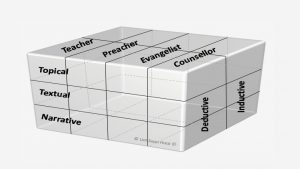
Christians grow in the Word through four primary ways: sermons, Bible classes, small group discussion, and personal study (including daily devotional reading). They are all important, and none should be neglected.
They have the same ultimate objective – a believer’s growth in the Word (understanding) and through the Word (transformation). However, they don’t do it in the same way. The failure to distinguish them is one of the main reasons why sermons or small group Bible studies don’t impact people as much as they could.
The Sermon
 For example, the main purpose of a sermon is not about piling onto the listeners loads of biblical knowledge. Growth in Bible knowledge is more in line with teaching. This is not to say that a sermon has no teaching content. A sermon cannot qualify as a sermon if it is not biblically sound. A sermon must be based on teaching (biblical teaching); but a sermon is not teaching. The purpose of a sermon is to convey God’s message from the Bible. It is a word from God from the Word of God—a message from the passage. The purpose of a sermon is to speak into lives; to encourage, inspire, and correct; leading to life transformation (2 Tim 3:16-17).
For example, the main purpose of a sermon is not about piling onto the listeners loads of biblical knowledge. Growth in Bible knowledge is more in line with teaching. This is not to say that a sermon has no teaching content. A sermon cannot qualify as a sermon if it is not biblically sound. A sermon must be based on teaching (biblical teaching); but a sermon is not teaching. The purpose of a sermon is to convey God’s message from the Bible. It is a word from God from the Word of God—a message from the passage. The purpose of a sermon is to speak into lives; to encourage, inspire, and correct; leading to life transformation (2 Tim 3:16-17).
If that is the case, then preachers should not pack their sermons with loads of teaching material filled with multiple points and sub-points. To those who do, they should teach less and preach more. Conversely, preachers who tend to preach a point rather than from the biblical text, should make sure that their sermons are based on and derived from the biblical text; preferably from one main passage of the Bible.
Another mark that differentiates preaching from other forms of Bible learning is that a sermon does not allow for much, if any, “conversation” between the preacher and the listeners. This is simply because the nature of a sermon is proclamation rather than dialogue. Secondly, the setting of speaking to a crowd limits any kind of actual dialogue between preacher and listener.1
The Bible Study Discussion
On the other hand, the small group Bible study functions in the opposite way. The study leader is not a preacher; not even a teacher. The role of the study leader is to facilitate a discussion where all the members of the group are encouraged to contribute. The operative word is “discussion”.
There are many good reasons for the use small group discussion to study the Bible.
 A discussion is active learning through participation. Listening to sermons and Bible teaching are passive forms of learning. It is well documented that people learn better through active participation rather than passive listening.
A discussion is active learning through participation. Listening to sermons and Bible teaching are passive forms of learning. It is well documented that people learn better through active participation rather than passive listening.- In a discussion people are made to carefully think, or closely observe the Bible text before they respond. Similarly, they have to intently listen to what the others in the group are saying in order to meaningfully participate in the conversation.
- A discussion affords group learning as the members weigh each one’s contribution to the discussion.
- A discussion is more interesting than listening to a monologue. This is especially true if the Bible study leader, say, for a particular cell group meeting, is not a gifted teacher.2 In a discussion, however, regardless of the leader’s level of gifting as a teacher, everyone is invited to participate. It inevitably creates more interest. For example, a view may be shared, which may be affirmed, refuted or refined by others. All this leads to a vibrant group conversation.
I believe most people are able to lead a discussion. Training on how to conduct a group Bible study discussion will certainly help. Following some key pointers on how to conduct a discussion is sufficient for anyone to comfortably lead a discussion. I will write more on this in my next blog post.
You may want to read my article “The Critical Point when Facilitating a Bible Study Discussion.”
 What is a Predictable Sermon?
What is a Predictable Sermon? 
 later. That is to say, there is a “wait for it” element in the movement of the sermon. Some teachers of homiletics have called this movement, “tension and resolution.”
later. That is to say, there is a “wait for it” element in the movement of the sermon. Some teachers of homiletics have called this movement, “tension and resolution.”
 This does not mean that a passage of Scripture cannot have a number of possible messages. The parable of the Lost Son, for example, may be used to preach different messages. The message depends on the preacher’s focus; is it on the prodigal son, the elder brother or the father? The message arising from a focus on the prodigal son may be about repentance, while that on the elder brother may be about self-righteousness, and the one on the father may be about unconditional love. The important factor that cannot be compromised is that the message must be faithful to sound exegesis of the passage.
This does not mean that a passage of Scripture cannot have a number of possible messages. The parable of the Lost Son, for example, may be used to preach different messages. The message depends on the preacher’s focus; is it on the prodigal son, the elder brother or the father? The message arising from a focus on the prodigal son may be about repentance, while that on the elder brother may be about self-righteousness, and the one on the father may be about unconditional love. The important factor that cannot be compromised is that the message must be faithful to sound exegesis of the passage.


 In the context of Jeremiah 29:13, obviously seeking God is not simply about hearing what the Lord has to say—they had just heard from Him. Seeking God in this case was about the exiles aligning themselves to Him and His purpose. It is one thing to know what the Lord wants—it is another thing to align ourselves to what He says.
In the context of Jeremiah 29:13, obviously seeking God is not simply about hearing what the Lord has to say—they had just heard from Him. Seeking God in this case was about the exiles aligning themselves to Him and His purpose. It is one thing to know what the Lord wants—it is another thing to align ourselves to what He says.
 As I spoke, I said to the church, “I don’t know what your expectations are. But, then again, maybe I do. In a crowd like this the expectations are many and varied. You may have gone along on the same journey, but perceptions are different, interpretation of events are different, internalisation of the experiences are different. And depending on what you feel is important you will also expect those things to be addressed as quickly as possible. They are all valid and good. We are all good Christians who want no less than the good of the church. But good must give way to…?”
As I spoke, I said to the church, “I don’t know what your expectations are. But, then again, maybe I do. In a crowd like this the expectations are many and varied. You may have gone along on the same journey, but perceptions are different, interpretation of events are different, internalisation of the experiences are different. And depending on what you feel is important you will also expect those things to be addressed as quickly as possible. They are all valid and good. We are all good Christians who want no less than the good of the church. But good must give way to…?”